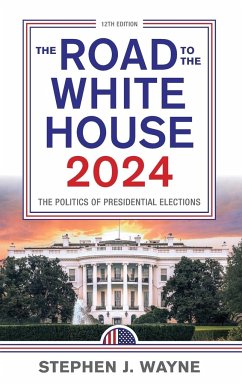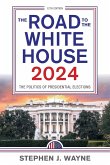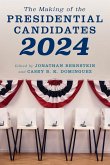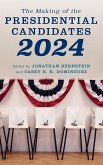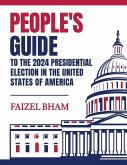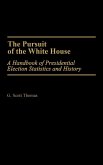- Gebundenes Buch
- Merkliste
- Auf die Merkliste
- Bewerten Bewerten
- Teilen
- Produkt teilen
- Produkterinnerung
- Produkterinnerung
This book equips students with a background on presidential elections and a guide to the 2024 election. It illustrates the strengths and weaknesses of our electoral democracy and offers insights on changes that have revolutionized contemporary electoral politics.
Andere Kunden interessierten sich auch für
![The Road to the White House 2024 The Road to the White House 2024]() Stephen J. WayneThe Road to the White House 202464,99 €
Stephen J. WayneThe Road to the White House 202464,99 €![America's Cultural Revolution America's Cultural Revolution]() Christopher F. RufoAmerica's Cultural Revolution22,99 €
Christopher F. RufoAmerica's Cultural Revolution22,99 €![The Making of the Presidential Candidates 2024 The Making of the Presidential Candidates 2024]() The Making of the Presidential Candidates 202439,99 €
The Making of the Presidential Candidates 202439,99 €![The Making of the Presidential Candidates 2024 The Making of the Presidential Candidates 2024]() The Making of the Presidential Candidates 202495,99 €
The Making of the Presidential Candidates 202495,99 €![People's Guide to the 2024 Presidential Election in the United States of America People's Guide to the 2024 Presidential Election in the United States of America]() Faizel BhamPeople's Guide to the 2024 Presidential Election in the United States of America53,99 €
Faizel BhamPeople's Guide to the 2024 Presidential Election in the United States of America53,99 €![Electable Electable]() Ali VitaliElectable20,99 €
Ali VitaliElectable20,99 €![The Pursuit of the White House The Pursuit of the White House]() G. Scott ThomasThe Pursuit of the White House85,99 €
G. Scott ThomasThe Pursuit of the White House85,99 €-
-
-
This book equips students with a background on presidential elections and a guide to the 2024 election. It illustrates the strengths and weaknesses of our electoral democracy and offers insights on changes that have revolutionized contemporary electoral politics.
Hinweis: Dieser Artikel kann nur an eine deutsche Lieferadresse ausgeliefert werden.
Hinweis: Dieser Artikel kann nur an eine deutsche Lieferadresse ausgeliefert werden.
Produktdetails
- Produktdetails
- Verlag: Rowman & Littlefield Publishers
- 12th Edition
- Seitenzahl: 296
- Erscheinungstermin: 15. Juni 2023
- Englisch
- Abmessung: 235mm x 157mm x 21mm
- Gewicht: 582g
- ISBN-13: 9781538182031
- ISBN-10: 1538182033
- Artikelnr.: 67655361
- Herstellerkennzeichnung
- Libri GmbH
- Europaallee 1
- 36244 Bad Hersfeld
- gpsr@libri.de
- Verlag: Rowman & Littlefield Publishers
- 12th Edition
- Seitenzahl: 296
- Erscheinungstermin: 15. Juni 2023
- Englisch
- Abmessung: 235mm x 157mm x 21mm
- Gewicht: 582g
- ISBN-13: 9781538182031
- ISBN-10: 1538182033
- Artikelnr.: 67655361
- Herstellerkennzeichnung
- Libri GmbH
- Europaallee 1
- 36244 Bad Hersfeld
- gpsr@libri.de
By Stephen J. Wayne
1. Part One. The Electoral Arena
2. Chapter 1. Presidential Selection: A Historical Overview
3. The Creation of the Electoral College
4. The Development of Nominating Systems
* Congressional Caucuses
* National Nominating Conventions
* Popular Primaries and Caucuses
5. The Evolution of the General Election
* Partisan Electors
* Congressional Decisions
* Judicial Determination
* Other Close Elections
6. The Politics of Electoral College Voting
7. Summary
8. Where on the Web?
9. Exercises
10. Selected Readings
11. Chapter 2. Campaign Finance
12. The Rising Costs of Running for President
13. The Regulation of Campaign Finance
* The Federal Election Campaign Act
* The Buckley v. Valeo Decision
* The Soft Money Loophole and Other Amendments
* The Bipartisan Campaign Reform Act
* The Court's Citizens United Decision
14. The Money Explosion
* Candidate Revenues
* Federal Funds
* Campaign Expenditures
15. Money and Electoral Success
16. Summary
17. Where on the Web?
18. Exercises
19. Selected Readings
20. Chapter 3. The Political Environment
21. Turnout
* The Evolution of Voting in American Elections
* Comparative Turnout in Other Countries
* Influences on Turnout
* Turnout and Democracy
* Turnout and Partisanship
22. The Partisan Basis of Politics
* Voting Behavior
* Shifts in Partisanship
23. The Social Basis of Politics
* The New Deal Realignment
* Evolving Political Coalitions: 1950-70
* Electoral Coalitions: The Last Forty Years
24. Summary
25. Where on the Web?
26. Exercises
27. Selected Readings
28. Part Two. The Nomination
29. Chapter 4. Party Rules and Their Impact
30. Reforming the Nomination Process: Democrats Take the Initiative
* Fixing the Calendar
* Improving Representation
* Empowering the Leadership
31. Republican Reforms
32. Legality of Party Rules
33. The Impact of the Rule Changes
* Turnout
* Representation
* Party Organization and Leadership
* Winners and Losers
34. Summary
35. Where on the Web?
36. Exercises
37. Selected Readings
38. Chapter 5. Campaigning for the Nomination
39. Basic Strategic Guidelines
* Plan Far Ahead
* Concentrate Efforts in the Early Contests
* Raise and Spend Big Bucks
* Gain Media Attention
* Develop an Organization
* Monitor Public Opinion
* Design and Target a Distinctive Image and Message
* Make Effective Use of Communication Technologies
40. Coordinating Strategy with Candidacy Status
* Campaigning as Front-Runner
* Campaigning as a Non-Front-Runner
* Campaigning as a Pulpit Candidate
41. Summary
42. Where on the Web?
43. Exercises
44. Selected Readings
45. Chapter 6. The Post-Primary Campaign
46. The Noncompetitive Preconvention Phase
* Healing Partisan Discord
* Repositioning and Reprioritizing the Issues
* Repairing Leadership Images
* Gaining the Stature of an Incumbent
* Picking the Vice Presidential Nominee
* Planning for the Convention
47. Convention Controversies in Historical Perspective
48. Contemporary Conventions: Composition, Content, Communications, and Impact
* Oratory
* Themes
* Platform
* News Media Coverage
* Assessing the Conventions' Impact on the Electorate
49. Characteristics of the Nominees
50. Summary
51. Where on the Web?
52. Exercises
53. Selected Readings
54. Part Three. The General Election Campaign
55. Chapter 7. Strategy, Tactics, and Operations
56. The Evolution of Presidential Campaigns
* From Porch to Train
* From Rally to Radio and Television
* From Art to Science: The Digital Revolution
57. Strategic Planning
* Partisanship
* Salient Issues
* Leadership Imagery
* Dealing with Incumbency
* Building a Winning Electoral College Coalition
58. Strategic Execution
* Organization
* The Public Dimension
* Field Offices
* Data Analysis
59. Summary
60. Where on the Web?
61. Exercises
62. Selected Readings
63. Chapter 8. Media Politics
64. The Mass Media and Electoral Politics: An Overview
* Print Media
* Television
* The Internet
65. Traditional News Coverage
* Horse Race Journalism
* Newsworthiness: Bad News Is "Good" News
* Story Lines
* Impact
66. Presidential Debates
* History
* Preparation
* Impact
67. Campaign Advertising
* Format and Tone
* Emotive Content
* Accuracy and Truthfulness
68. Digital Communication Controversies
* Foreign Interference
* Use and Abuse of Personal Data
69. Summary
70. Where on the Web?
71. Exercises
72. Selected Readings
73. Part Four. The Election: Its Meaning and Consequences
74. Chapter 9. Understanding Presidential Elections
75. Predicting Presidential Elections
* Forecasting Models
* Pre-election Polling
* Election-Night Reporting and Analyses of Exit Polls
76. Interpreting the Election Results
* Models of Voting Behavior
* Explaining Presidential Election Results: 1952-2016
77. Converting Electoral Choice into Public Policy
* The President's Imprecise Mandate
* Campaign Expectations and Presidential Performance
* Transitioning into Office
78. Summary
79. Where on the Web?
80. Exercises
81. Selected Readings
82. Chapter 10. Reforming the Electoral System
83. Improving the Selection Process
* Party Rules
* Campaign Finance
84. Informing the Electorate
* Traditional News Coverage
* Digital Communications
85. Democratizing the Road to the White House
* Closing the Participation Divide
* Changing the Way Presidents Are Elected
86. Increasing Competitiveness for Congressional Elections
87. Summary
88. Where on the Web?
89. Exercises
90. Selected Readings
91. Appendix. The 2019-2020 Presidential Election Campaign
2. Chapter 1. Presidential Selection: A Historical Overview
3. The Creation of the Electoral College
4. The Development of Nominating Systems
* Congressional Caucuses
* National Nominating Conventions
* Popular Primaries and Caucuses
5. The Evolution of the General Election
* Partisan Electors
* Congressional Decisions
* Judicial Determination
* Other Close Elections
6. The Politics of Electoral College Voting
7. Summary
8. Where on the Web?
9. Exercises
10. Selected Readings
11. Chapter 2. Campaign Finance
12. The Rising Costs of Running for President
13. The Regulation of Campaign Finance
* The Federal Election Campaign Act
* The Buckley v. Valeo Decision
* The Soft Money Loophole and Other Amendments
* The Bipartisan Campaign Reform Act
* The Court's Citizens United Decision
14. The Money Explosion
* Candidate Revenues
* Federal Funds
* Campaign Expenditures
15. Money and Electoral Success
16. Summary
17. Where on the Web?
18. Exercises
19. Selected Readings
20. Chapter 3. The Political Environment
21. Turnout
* The Evolution of Voting in American Elections
* Comparative Turnout in Other Countries
* Influences on Turnout
* Turnout and Democracy
* Turnout and Partisanship
22. The Partisan Basis of Politics
* Voting Behavior
* Shifts in Partisanship
23. The Social Basis of Politics
* The New Deal Realignment
* Evolving Political Coalitions: 1950-70
* Electoral Coalitions: The Last Forty Years
24. Summary
25. Where on the Web?
26. Exercises
27. Selected Readings
28. Part Two. The Nomination
29. Chapter 4. Party Rules and Their Impact
30. Reforming the Nomination Process: Democrats Take the Initiative
* Fixing the Calendar
* Improving Representation
* Empowering the Leadership
31. Republican Reforms
32. Legality of Party Rules
33. The Impact of the Rule Changes
* Turnout
* Representation
* Party Organization and Leadership
* Winners and Losers
34. Summary
35. Where on the Web?
36. Exercises
37. Selected Readings
38. Chapter 5. Campaigning for the Nomination
39. Basic Strategic Guidelines
* Plan Far Ahead
* Concentrate Efforts in the Early Contests
* Raise and Spend Big Bucks
* Gain Media Attention
* Develop an Organization
* Monitor Public Opinion
* Design and Target a Distinctive Image and Message
* Make Effective Use of Communication Technologies
40. Coordinating Strategy with Candidacy Status
* Campaigning as Front-Runner
* Campaigning as a Non-Front-Runner
* Campaigning as a Pulpit Candidate
41. Summary
42. Where on the Web?
43. Exercises
44. Selected Readings
45. Chapter 6. The Post-Primary Campaign
46. The Noncompetitive Preconvention Phase
* Healing Partisan Discord
* Repositioning and Reprioritizing the Issues
* Repairing Leadership Images
* Gaining the Stature of an Incumbent
* Picking the Vice Presidential Nominee
* Planning for the Convention
47. Convention Controversies in Historical Perspective
48. Contemporary Conventions: Composition, Content, Communications, and Impact
* Oratory
* Themes
* Platform
* News Media Coverage
* Assessing the Conventions' Impact on the Electorate
49. Characteristics of the Nominees
50. Summary
51. Where on the Web?
52. Exercises
53. Selected Readings
54. Part Three. The General Election Campaign
55. Chapter 7. Strategy, Tactics, and Operations
56. The Evolution of Presidential Campaigns
* From Porch to Train
* From Rally to Radio and Television
* From Art to Science: The Digital Revolution
57. Strategic Planning
* Partisanship
* Salient Issues
* Leadership Imagery
* Dealing with Incumbency
* Building a Winning Electoral College Coalition
58. Strategic Execution
* Organization
* The Public Dimension
* Field Offices
* Data Analysis
59. Summary
60. Where on the Web?
61. Exercises
62. Selected Readings
63. Chapter 8. Media Politics
64. The Mass Media and Electoral Politics: An Overview
* Print Media
* Television
* The Internet
65. Traditional News Coverage
* Horse Race Journalism
* Newsworthiness: Bad News Is "Good" News
* Story Lines
* Impact
66. Presidential Debates
* History
* Preparation
* Impact
67. Campaign Advertising
* Format and Tone
* Emotive Content
* Accuracy and Truthfulness
68. Digital Communication Controversies
* Foreign Interference
* Use and Abuse of Personal Data
69. Summary
70. Where on the Web?
71. Exercises
72. Selected Readings
73. Part Four. The Election: Its Meaning and Consequences
74. Chapter 9. Understanding Presidential Elections
75. Predicting Presidential Elections
* Forecasting Models
* Pre-election Polling
* Election-Night Reporting and Analyses of Exit Polls
76. Interpreting the Election Results
* Models of Voting Behavior
* Explaining Presidential Election Results: 1952-2016
77. Converting Electoral Choice into Public Policy
* The President's Imprecise Mandate
* Campaign Expectations and Presidential Performance
* Transitioning into Office
78. Summary
79. Where on the Web?
80. Exercises
81. Selected Readings
82. Chapter 10. Reforming the Electoral System
83. Improving the Selection Process
* Party Rules
* Campaign Finance
84. Informing the Electorate
* Traditional News Coverage
* Digital Communications
85. Democratizing the Road to the White House
* Closing the Participation Divide
* Changing the Way Presidents Are Elected
86. Increasing Competitiveness for Congressional Elections
87. Summary
88. Where on the Web?
89. Exercises
90. Selected Readings
91. Appendix. The 2019-2020 Presidential Election Campaign
1. Part One. The Electoral Arena
2. Chapter 1. Presidential Selection: A Historical Overview
3. The Creation of the Electoral College
4. The Development of Nominating Systems
* Congressional Caucuses
* National Nominating Conventions
* Popular Primaries and Caucuses
5. The Evolution of the General Election
* Partisan Electors
* Congressional Decisions
* Judicial Determination
* Other Close Elections
6. The Politics of Electoral College Voting
7. Summary
8. Where on the Web?
9. Exercises
10. Selected Readings
11. Chapter 2. Campaign Finance
12. The Rising Costs of Running for President
13. The Regulation of Campaign Finance
* The Federal Election Campaign Act
* The Buckley v. Valeo Decision
* The Soft Money Loophole and Other Amendments
* The Bipartisan Campaign Reform Act
* The Court's Citizens United Decision
14. The Money Explosion
* Candidate Revenues
* Federal Funds
* Campaign Expenditures
15. Money and Electoral Success
16. Summary
17. Where on the Web?
18. Exercises
19. Selected Readings
20. Chapter 3. The Political Environment
21. Turnout
* The Evolution of Voting in American Elections
* Comparative Turnout in Other Countries
* Influences on Turnout
* Turnout and Democracy
* Turnout and Partisanship
22. The Partisan Basis of Politics
* Voting Behavior
* Shifts in Partisanship
23. The Social Basis of Politics
* The New Deal Realignment
* Evolving Political Coalitions: 1950-70
* Electoral Coalitions: The Last Forty Years
24. Summary
25. Where on the Web?
26. Exercises
27. Selected Readings
28. Part Two. The Nomination
29. Chapter 4. Party Rules and Their Impact
30. Reforming the Nomination Process: Democrats Take the Initiative
* Fixing the Calendar
* Improving Representation
* Empowering the Leadership
31. Republican Reforms
32. Legality of Party Rules
33. The Impact of the Rule Changes
* Turnout
* Representation
* Party Organization and Leadership
* Winners and Losers
34. Summary
35. Where on the Web?
36. Exercises
37. Selected Readings
38. Chapter 5. Campaigning for the Nomination
39. Basic Strategic Guidelines
* Plan Far Ahead
* Concentrate Efforts in the Early Contests
* Raise and Spend Big Bucks
* Gain Media Attention
* Develop an Organization
* Monitor Public Opinion
* Design and Target a Distinctive Image and Message
* Make Effective Use of Communication Technologies
40. Coordinating Strategy with Candidacy Status
* Campaigning as Front-Runner
* Campaigning as a Non-Front-Runner
* Campaigning as a Pulpit Candidate
41. Summary
42. Where on the Web?
43. Exercises
44. Selected Readings
45. Chapter 6. The Post-Primary Campaign
46. The Noncompetitive Preconvention Phase
* Healing Partisan Discord
* Repositioning and Reprioritizing the Issues
* Repairing Leadership Images
* Gaining the Stature of an Incumbent
* Picking the Vice Presidential Nominee
* Planning for the Convention
47. Convention Controversies in Historical Perspective
48. Contemporary Conventions: Composition, Content, Communications, and Impact
* Oratory
* Themes
* Platform
* News Media Coverage
* Assessing the Conventions' Impact on the Electorate
49. Characteristics of the Nominees
50. Summary
51. Where on the Web?
52. Exercises
53. Selected Readings
54. Part Three. The General Election Campaign
55. Chapter 7. Strategy, Tactics, and Operations
56. The Evolution of Presidential Campaigns
* From Porch to Train
* From Rally to Radio and Television
* From Art to Science: The Digital Revolution
57. Strategic Planning
* Partisanship
* Salient Issues
* Leadership Imagery
* Dealing with Incumbency
* Building a Winning Electoral College Coalition
58. Strategic Execution
* Organization
* The Public Dimension
* Field Offices
* Data Analysis
59. Summary
60. Where on the Web?
61. Exercises
62. Selected Readings
63. Chapter 8. Media Politics
64. The Mass Media and Electoral Politics: An Overview
* Print Media
* Television
* The Internet
65. Traditional News Coverage
* Horse Race Journalism
* Newsworthiness: Bad News Is "Good" News
* Story Lines
* Impact
66. Presidential Debates
* History
* Preparation
* Impact
67. Campaign Advertising
* Format and Tone
* Emotive Content
* Accuracy and Truthfulness
68. Digital Communication Controversies
* Foreign Interference
* Use and Abuse of Personal Data
69. Summary
70. Where on the Web?
71. Exercises
72. Selected Readings
73. Part Four. The Election: Its Meaning and Consequences
74. Chapter 9. Understanding Presidential Elections
75. Predicting Presidential Elections
* Forecasting Models
* Pre-election Polling
* Election-Night Reporting and Analyses of Exit Polls
76. Interpreting the Election Results
* Models of Voting Behavior
* Explaining Presidential Election Results: 1952-2016
77. Converting Electoral Choice into Public Policy
* The President's Imprecise Mandate
* Campaign Expectations and Presidential Performance
* Transitioning into Office
78. Summary
79. Where on the Web?
80. Exercises
81. Selected Readings
82. Chapter 10. Reforming the Electoral System
83. Improving the Selection Process
* Party Rules
* Campaign Finance
84. Informing the Electorate
* Traditional News Coverage
* Digital Communications
85. Democratizing the Road to the White House
* Closing the Participation Divide
* Changing the Way Presidents Are Elected
86. Increasing Competitiveness for Congressional Elections
87. Summary
88. Where on the Web?
89. Exercises
90. Selected Readings
91. Appendix. The 2019-2020 Presidential Election Campaign
2. Chapter 1. Presidential Selection: A Historical Overview
3. The Creation of the Electoral College
4. The Development of Nominating Systems
* Congressional Caucuses
* National Nominating Conventions
* Popular Primaries and Caucuses
5. The Evolution of the General Election
* Partisan Electors
* Congressional Decisions
* Judicial Determination
* Other Close Elections
6. The Politics of Electoral College Voting
7. Summary
8. Where on the Web?
9. Exercises
10. Selected Readings
11. Chapter 2. Campaign Finance
12. The Rising Costs of Running for President
13. The Regulation of Campaign Finance
* The Federal Election Campaign Act
* The Buckley v. Valeo Decision
* The Soft Money Loophole and Other Amendments
* The Bipartisan Campaign Reform Act
* The Court's Citizens United Decision
14. The Money Explosion
* Candidate Revenues
* Federal Funds
* Campaign Expenditures
15. Money and Electoral Success
16. Summary
17. Where on the Web?
18. Exercises
19. Selected Readings
20. Chapter 3. The Political Environment
21. Turnout
* The Evolution of Voting in American Elections
* Comparative Turnout in Other Countries
* Influences on Turnout
* Turnout and Democracy
* Turnout and Partisanship
22. The Partisan Basis of Politics
* Voting Behavior
* Shifts in Partisanship
23. The Social Basis of Politics
* The New Deal Realignment
* Evolving Political Coalitions: 1950-70
* Electoral Coalitions: The Last Forty Years
24. Summary
25. Where on the Web?
26. Exercises
27. Selected Readings
28. Part Two. The Nomination
29. Chapter 4. Party Rules and Their Impact
30. Reforming the Nomination Process: Democrats Take the Initiative
* Fixing the Calendar
* Improving Representation
* Empowering the Leadership
31. Republican Reforms
32. Legality of Party Rules
33. The Impact of the Rule Changes
* Turnout
* Representation
* Party Organization and Leadership
* Winners and Losers
34. Summary
35. Where on the Web?
36. Exercises
37. Selected Readings
38. Chapter 5. Campaigning for the Nomination
39. Basic Strategic Guidelines
* Plan Far Ahead
* Concentrate Efforts in the Early Contests
* Raise and Spend Big Bucks
* Gain Media Attention
* Develop an Organization
* Monitor Public Opinion
* Design and Target a Distinctive Image and Message
* Make Effective Use of Communication Technologies
40. Coordinating Strategy with Candidacy Status
* Campaigning as Front-Runner
* Campaigning as a Non-Front-Runner
* Campaigning as a Pulpit Candidate
41. Summary
42. Where on the Web?
43. Exercises
44. Selected Readings
45. Chapter 6. The Post-Primary Campaign
46. The Noncompetitive Preconvention Phase
* Healing Partisan Discord
* Repositioning and Reprioritizing the Issues
* Repairing Leadership Images
* Gaining the Stature of an Incumbent
* Picking the Vice Presidential Nominee
* Planning for the Convention
47. Convention Controversies in Historical Perspective
48. Contemporary Conventions: Composition, Content, Communications, and Impact
* Oratory
* Themes
* Platform
* News Media Coverage
* Assessing the Conventions' Impact on the Electorate
49. Characteristics of the Nominees
50. Summary
51. Where on the Web?
52. Exercises
53. Selected Readings
54. Part Three. The General Election Campaign
55. Chapter 7. Strategy, Tactics, and Operations
56. The Evolution of Presidential Campaigns
* From Porch to Train
* From Rally to Radio and Television
* From Art to Science: The Digital Revolution
57. Strategic Planning
* Partisanship
* Salient Issues
* Leadership Imagery
* Dealing with Incumbency
* Building a Winning Electoral College Coalition
58. Strategic Execution
* Organization
* The Public Dimension
* Field Offices
* Data Analysis
59. Summary
60. Where on the Web?
61. Exercises
62. Selected Readings
63. Chapter 8. Media Politics
64. The Mass Media and Electoral Politics: An Overview
* Print Media
* Television
* The Internet
65. Traditional News Coverage
* Horse Race Journalism
* Newsworthiness: Bad News Is "Good" News
* Story Lines
* Impact
66. Presidential Debates
* History
* Preparation
* Impact
67. Campaign Advertising
* Format and Tone
* Emotive Content
* Accuracy and Truthfulness
68. Digital Communication Controversies
* Foreign Interference
* Use and Abuse of Personal Data
69. Summary
70. Where on the Web?
71. Exercises
72. Selected Readings
73. Part Four. The Election: Its Meaning and Consequences
74. Chapter 9. Understanding Presidential Elections
75. Predicting Presidential Elections
* Forecasting Models
* Pre-election Polling
* Election-Night Reporting and Analyses of Exit Polls
76. Interpreting the Election Results
* Models of Voting Behavior
* Explaining Presidential Election Results: 1952-2016
77. Converting Electoral Choice into Public Policy
* The President's Imprecise Mandate
* Campaign Expectations and Presidential Performance
* Transitioning into Office
78. Summary
79. Where on the Web?
80. Exercises
81. Selected Readings
82. Chapter 10. Reforming the Electoral System
83. Improving the Selection Process
* Party Rules
* Campaign Finance
84. Informing the Electorate
* Traditional News Coverage
* Digital Communications
85. Democratizing the Road to the White House
* Closing the Participation Divide
* Changing the Way Presidents Are Elected
86. Increasing Competitiveness for Congressional Elections
87. Summary
88. Where on the Web?
89. Exercises
90. Selected Readings
91. Appendix. The 2019-2020 Presidential Election Campaign

